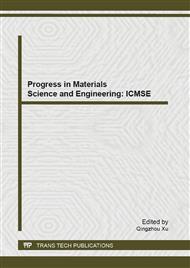p.448
p.457
p.465
p.469
p.473
p.478
p.484
p.490
p.496
New Opportunities in Lead Selenide Nanolayers
Abstract:
The article deals with the peculiarities of creation of effective negative pressure and the increase in the forbidden gap width in PbSe nanolayers. The dielectric state that maybe realized under these conditions and their appropriate doping can be considered as a new resource in lead selenide nanolayers. The increasing of the tangential lattice constant with higher growth temperature and layer growth rate confirms this consideration. When determining the forbidden gap width, the optical transmission spectra were processed by a model of the Fabry-Perot interferometer, and, at high concentration of free current carriers, the absorption on them and their degeneracy were taken into consideration.
Info:
Periodical:
Pages:
473-477
Citation:
Online since:
October 2013
Price:
Сopyright:
© 2013 Trans Tech Publications Ltd. All Rights Reserved
Share:
Citation:


